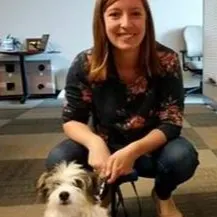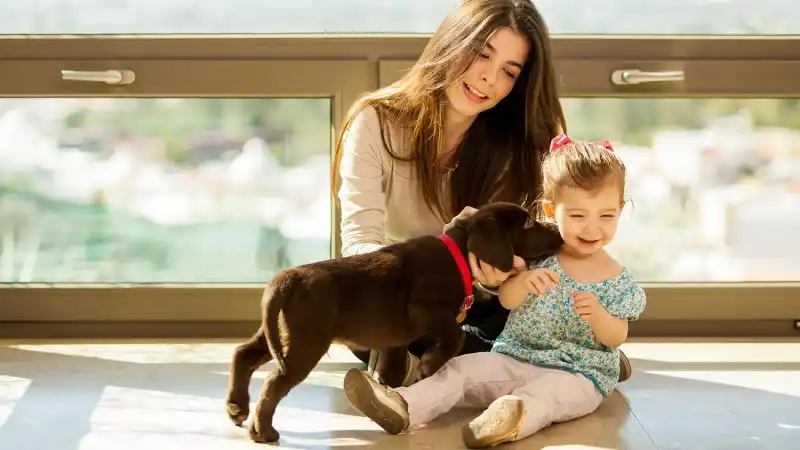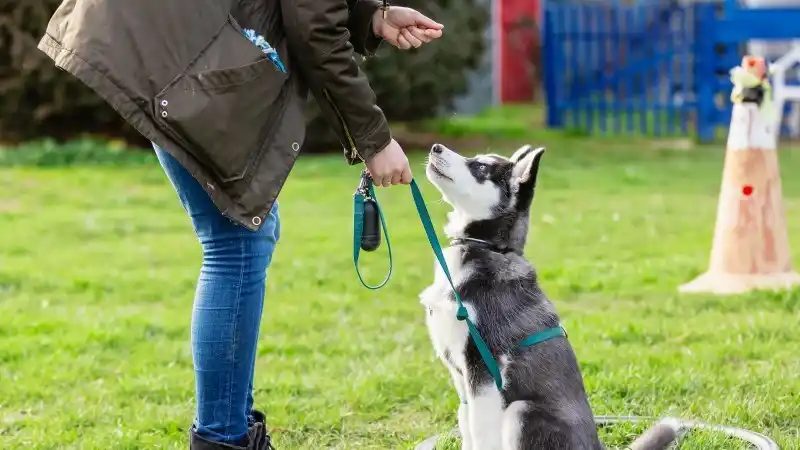How to Train a Farm Dog
Farm dog training includes understanding farm safety and animal behavior. Here are tips for training your farm dog in the fields or in the barnyard.

Whether you’re raising a new puppy for farm dog training or simply want to introduce your dog to the sights and sounds of a barnyard, it’s important to understand some basic farm safety. Here are our tips for training your farm dog!
Welcome to the Farm
_When_you train a farm dog is just as important as how you train a farm dog. Before your dog starts farm dog training, they need to learn basic commands such as sit, come, stay, drop, leave it, and down. They should react to these commands every time they are given, instead of when they feel like it. Remember that everything on the farm is new and exciting, so lots of treats and praise may be necessary to reinforce positive behaviors. If your pup gets into a dangerous situation during farm dog training, it’s important that you can get their attention and take control of the situation before your dog (or another animal) gets injured.
Take your dog’s introduction to the barn and farm slowly. Work on a leash so you have control of your dog and can keep them out of harm’s way. Walk around the farm (without other animals present, if possible) to get your dog comfortable in these new surroundings. Many dogs will become excited with the new sights and smells, and may forgot some of their basic training. If your dog becomes too overwhelmed and is no longer listening to commands, remove them from the farm and go back to a neutral zone where they can calm down. It may take several short visits to the property before your dog is comfortable and calm enough to meet the barn residents.
Farm Animal Safety
When you introduce your dog to farm animals you should immediately teach them what is acceptable and what won’t be tolerated. Don’t allow your dog to chase the other animals or bark at them. This sort of rude behavior can stress out your dog and the farm animals and may lead to a provoked animal lashing out at your dog. Teach your pup that their job is to stay nearby and watch (unless you intend to train them for herding or another farm-related job). The best way to teach them is to keep them on a leash and introduce the animals slowly - one at a time if possible.
Meeting Small Animals
When introducing smaller animals, such as chickens or rabbits, you should have two people on hand - one to hold the small animal and the other to control the dog. Let your dog sniff the small animal, but then ask for their attention and reward them for listening. If your dog acts aggressively or seems too eager to meet the new animal, try removing them from the situation until they're ready to listen. Repeat the introductions until your dog is happy to ignore the small animal and instead keep their focus on you.
Livestock Training for Dogs
If you are training a farm dog to be around a large animal such as a horse or cow, keep a fence between the two animals to start. Allow the horse/cow the freedom to move away from the fencing should they become stressed out by the situation. Try to find a large animal that is already comfortable with dogs, so your dog is the only one having a new experience. Let them sniff over the fence, but correct aggressive behavior with a firm “no” and take your dog away to calm down if needed.
Reward your dog with treats and praise for good behavior, such as approaching and sniffing the other animal in a calm, quiet manner. Once your dog is reacting positively to meeting over the fence, you can try an “exposed” introduction where your dog meets the other animal without anything between them. Ensure there are two people for this process, so one can handle the farm animal and you can have your full attention on your dog.
It may take a few sessions of introducing your dog to each species of farm animal before they're comfortable around them. Your dog should respect the other farm animals (especially the larger variety) and know to stay in their own personal space.
Containing Your Canine
From your dog’s first day of farm dog training, you should create off-limit areas. These will be areas such as enclosed pastures, bird coops, feed rooms, barn stalls, or riding areas that your dog is absolutely not allowed to enter. Your dog may need to stay leashed or gated in the area that you’re working in for the first few years, so that you can keep a close eye on them and ensure they're not sneaking off to break the rules.
Even after they've completed their farm dog training, there should be solid fencing encompassing the perimeter of the farm so that your dog can’t escape. Country roads often have traffic, which could result in your dog getting struck by a car and injured. It’s important to be a good neighbor as well, and your dog wandering into the barn next door could lead to trouble.
Fencing off certain areas of the farm to keep your dog out may be the best option for keeping them safe. Fence off fields and vegetable patches that could contain plants that are toxic to dogs, such as tomatoes and rhubarb. Consider choosing livestock fencing, which is constructed to stop animals from sneaking beneath and directly interacting with other animals. One well-aimed kick from a cow or horse could significantly injure a dog.
Feed Room Concerns
Training a farm dog to keep out of livestock feed rooms is essential. The sweet-smelling livestock feed is quite tempting for dogs, but the high grain and fiber content can change the pH in your dog’s hindgut, leading to gas, an upset stomach, and loose stool. If the farm animals are fed supplements or medications, they are also commonly stored in the feed room and could be toxic to your dog if consumed.
Beware of Toxins
Many livestock dewormers (Moxidectin and Ivermectin) are also toxic to dogs and can cause drooling, incoordination, dilated pupils, seizures, and even comas. Ensure that syringes are disposed of safely around the farm and clean up any dropped doses that end up on the ground. Keep your dog out of manure piles for a few days after dewormers are given, since some remnants of the medicine and dead worms may end up in the manure.
Ensure all pesticides, rodenticides, gas/diesel, and antifreeze are stored out of your dog's reach. These poisons can have an alluring smell to dogs, but are extremely toxic. Teach your dog that areas with farm equipment such as tractors, tillers, etc. are off limits. Dogs who become comfortable around heavy farm machinery may not realize their hazard when being operated and can easily become injured or killed.
Hoof Trimmings: A Safe Treat?
When horses get their hooves trimmed, the farrier usually leaves the trimmings behind. Horse hoof walls are made of special keratinized skin cells that are digestible when soft and flexible. As the trimmings dry and harden, they become a danger when ingested, as they can irritate the internal tissues in the esophagus, stomach, and intestines. Even soft, flexible trimmings can cause irritation in your dog if the horse owner treats the horse’s hooves with any chemicals. It’s safest to train your farm dog not to eat hoof trimmings altogether, using a "leave it" command. Quickly cleaning up the trimmings is the best way to keep your pup safe.
Know Your Limits!
While many dogs can adjust to farm life, not all dogs are cut out for farm dog training. Even if you’ve mastered training a farm dog, some breeds have such strong hunting instincts that it’s difficult for them not to chase chickens or race after cows. Keeping these dogs on a leash or opting to leave them at home may be the best choice for you, your livestock, and your dog!
AKC Farm Dog Certified
Looking for more tips on training a farm dog? The American Kennel Club has a farm dog certification that asks your dog to perform a series of twelve exercises that are typical for a farm environment. Some of these exercises include walking around the farm, approaching livestock, reacting to another dog, and various other tasks. Preparing for and passing this test can help set your dog up for success!
Take some of the stress out of pet ownership with Accident & Illness Coverage from AKC Pet Insurance (underwritten by Independence American Insurance Company). Our pet insurance plans are designed to be there when you need them, allowing you to focus more on the health of your pet and less on costly veterinary bills.

Every Dog and Cat Deserves the Pet Insurance of Champions
Get prize-winning care for your pets.

Mary comes to AKC Pet Insurance with an extensive background in animal care. As a lifelong animal lover, she has a passion for promoting pet health and wellness. Mary lives in Kentucky with her orange kitty, "Cat" and her dog, " Wubbi".
READ MORE ARTICLES

